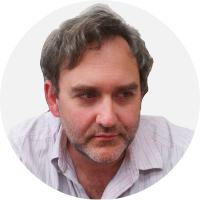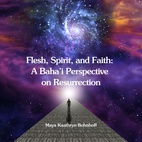The views expressed in our content reflect individual perspectives and do not represent the authoritative views of the Baha'i Faith.
Most religions have two consistent beliefs that popular understandings of physics appear to challenge – so how do the Baha’i teachings, which support the agreement of science and religion, respond?
The first belief involves a type of eternal existence which transcends the physical. The second is the existence of a type of “will” that works as an active and causal agent in the order of our universe.
Both of these ideas form the conceptual basis of an eternal soul and a deity – the main pillars around which most religions, including the Baha’i Faith, construct their belief system.
RELATED: Science and Religion: Can They Work Together?
Abdu’l-Baha, the son and appointed interpreter of Baha’u’llah’s revelation, addressed the challenge of understanding an eternal existence in the face of the transient nature of natural existence in several of his talks and writings. For example, in a talk he gave in Paris more than a century ago he explained:
The whole physical creation is perishable. These material bodies are composed of atoms; when these atoms begin to separate decomposition sets in, then comes what we call death. This composition of atoms, which constitutes the body or mortal element of any created being, is temporary. When the power of attraction, which holds these atoms together, is withdrawn, the body, as such, ceases to exist.
With the soul it is different. The soul is not a combination of elements, it is not composed of many atoms, it is of one indivisible substance and therefore eternal. It is entirely out of the order of the physical creation; it is immortal!
Scientific philosophy has demonstrated that a simple element (“simple” meaning “not composed”) is indestructible, eternal. The soul, not being a composition of elements, is, in character, as a simple element, and therefore cannot cease to exist. The soul, being of that one indivisible substance, can suffer neither disintegration nor destruction, therefore there is no reason for its coming to an end.
Interestingly, Abdu’l-Baha cited the example of a non-composed thing – in modern scientific parlance, a fundamental particle – to illustrate the possibility of an existence being eternal. He thus identifies the eternal soul as an elemental existence. More contemporary understandings of the nature of elemental particles or forces indicate that they represent eternal mathematical relationships which might pop in and out of existence, yet they remain eternally true and the same, in the way a mathematical reality is eternally true, like the existence of Pi or the number 3 remain the same no matter when it is written down.
In a speech he gave to the Theosophical Society in Boston in 1912, Abdu’l-Baha related this connection between the understanding of the soul and elementary particles to another seminal idea:
All the organisms of material creation are limited to an image or form. That is to say, each created material being is possessed of a form; it cannot possess two forms at the same time. For example, a body may be spherical, triangular or square; but it is impossible for it to be two of these shapes simultaneously. It may be triangular, but if it is to become square, it must first rid itself of the triangular shape. It is absolutely impossible for it to be both at the same time. Therefore, it is evident in the reality of material organisms that different forms cannot be simultaneously possessed. In the spiritual reality of man, however, all geometrical figures can be simultaneously conceived, while in physical realities one image must be forsaken in order that another may be possible. This is the law of change and transformation, and change and transformation are precursors of mortality. Were it not for this change in form, phenomena would be immortal; but because the phenomenal existence is subject to transformation, it is mortal. The reality of man, however, is possessed of all virtues; it is not necessary for him to give up one image for another as mere physical bodies do. Therefore, in that reality there is no change or transformation; it is immortal and everlasting.
The idea that the human soul can conceive of multiple contradictory forms is interestingly very similar to the modern scientific concept called “superposition.” One of the fascinating aspects of fundamental particles operating in the quantum mechanical regime is the fact that they can possess multiple contradictory attributes at the same time. This superposition of states persists until the attribute is measured.
Taking a Spiritual Concept Literally
Over two millennia ago Pythagoras and later Plato recorded an approach to the conceptualization of matter which exposed a transcendent and eternal property – namely that the form or mathematical relationships that underly and describe the observation of matter is eternal and transcends its individual physical expression. This basic understanding of matter and form implicitly underlies all mathematical physics, and its unbridled success in the construction of accurate modern theories of physics is evidence for the correctness of this view of nature.
Beginning with Plato’s own writings, the concepts of forms became somewhat confused and obscure, as a reading of the challenging Parmenides dialogue reveals. In it, Plato presents an elder Parmenides refuting a much younger Socrates’ presentation of the theory of forms. After demonstrating the flaws of Socrates’ conception of the theory of forms, he then goes on into a very long and difficult-to-understand series of logical arguments to defend the theory of forms. To this day philosophers debate the meaning of these logical arguments presented in Plato’s dialogue. Thus the theory of forms was never fully grasped, even at its inception.
Those problems of understanding stem from how some people tend to physicalize the concept of forms, when in truth it represents the pure abstraction of relationships. This can be seen especially in theology, when Pagan and later Abrahamic faiths attempted to use these philosophical concepts. For example, Pagan theologians tended to relate the higher universal forms to their gods. Later Christian theologians would use angels instead, attempting to physicalize spiritual themes.
These attempts to physicalize Platonic abstractions led to a literal understanding of scripture. For example, the understanding of spiritual resurrection expressed in the early Christian writings of the apostle Paul, who explained that “flesh and blood” do not go to heaven but instead “spiritual bodies” do, became physicalized later in the writings of St. Augustine of Hippo. Although St. Augustine was an admirer of Plato’s philosophy, he still wasn’t ready to embrace the concept of a purely spiritual resurrection and thus physicalized the concept of “spiritual bodies.”
The Question of a Divine Will
To the question of “will” as a causative agent, many contemporary physicists and philosophical materialists argue that will is an illusion – that in fact everything is describable by causal events. Thus, everything is determined, and there is no possible room for will.
They note that we have well-proven physical laws which describe causal relations with great precision, and that there also exists a component of apparent randomness. In none of these would they admit having the seemingly human attribute of will.
RELATED: Do You Believe in Free Will — or the Will of a Creator?
Yet a more careful exploration of this “randomness” exposes a very large gap in our views of causality.
The nature of this randomness is most likely unsolvable – is it true randomness or deterministic mechanics which only appear random? As well, the philosophical approach to the concept of randomness in mathematical statistics carries with it an implicit sense that it is known or even predictable. This masks the reality that, by definition, to assign something as “random” means we cannot make science-based predictions and do not have models to explain its behavior. If we did, it would no longer be random.
Thus, this randomness together with the known deterministic aspects of physical laws form something akin to what might be ascribed to the expression of the will of a deity.
That is, the Divine Will treats us according to well-established physical laws, yet still has will and the power to determine something arbitrarily if it so chooses. As an example, Baha’u’llah described the whole complex of nature as being an expression of the “Will of God:” “Say Nature is a manifestation of my name the maker the creator” he explains in his fascinating Tablet of Wisdom.
Obviously, then, these two challenges to religion from science – which form the backbone of all the claims that characterize science as being at odds with religion – are potentially solvable, provided one understands both religious scripture and the philosophical implications of modern science in a new way.
This new approach is both very ancient, yet consistent with modern physics. The spiritual and scientific insights which the Baha’i teachings bring forth prove highly illuminating, providing an important basis for understanding and reconciling traditional religion with modern science.
















Comments
Sign in or create an account
Continue with Googleor